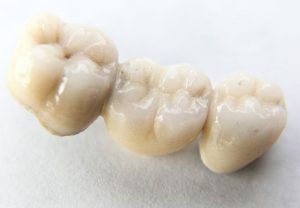One of the common consequences of having missing teeth is that adjacent teeth will tend to tip or drift into the gap. That interferes with the way the teeth mesh and creates a whole new set of problems. A bridge is one way to prevent undesirable drifting and tipping of adjacent teeth.
A bridges is ideal for people who don’t like removable dentures and only have one or a few teeth missing. Its purpose is to restore and maintain the function and appearance of the missing tooth or teeth.
 A bridge is usually made with crowns for the teeth on either side of the gap where a tooth or teeth are missing. False teeth, made of the same materials as the crowns, are attached to those crowns. The resulting bridge of three of more false teeth is cemented into place. The false teeth are in contact with the gum tissue of the gap and “pretend” to be growing out of the gum. The biting forces that the false teeth receive are entirely transmitted to the adjacent teeth via the crowns which form each end of the bridge.
A bridge is usually made with crowns for the teeth on either side of the gap where a tooth or teeth are missing. False teeth, made of the same materials as the crowns, are attached to those crowns. The resulting bridge of three of more false teeth is cemented into place. The false teeth are in contact with the gum tissue of the gap and “pretend” to be growing out of the gum. The biting forces that the false teeth receive are entirely transmitted to the adjacent teeth via the crowns which form each end of the bridge.
Bridges are only possible if you have enough strong teeth with good bone support. Dr Mclean will help you decide which is your best way of replacing missing teeth. The bridge can’t be removed by the patient. These bridges were usually made of precious metal bonded to porcelain. Nowadays, most bridges can be made without metal (zirconia.)
